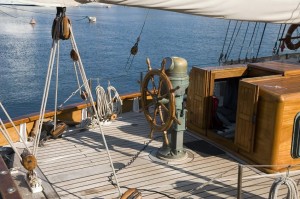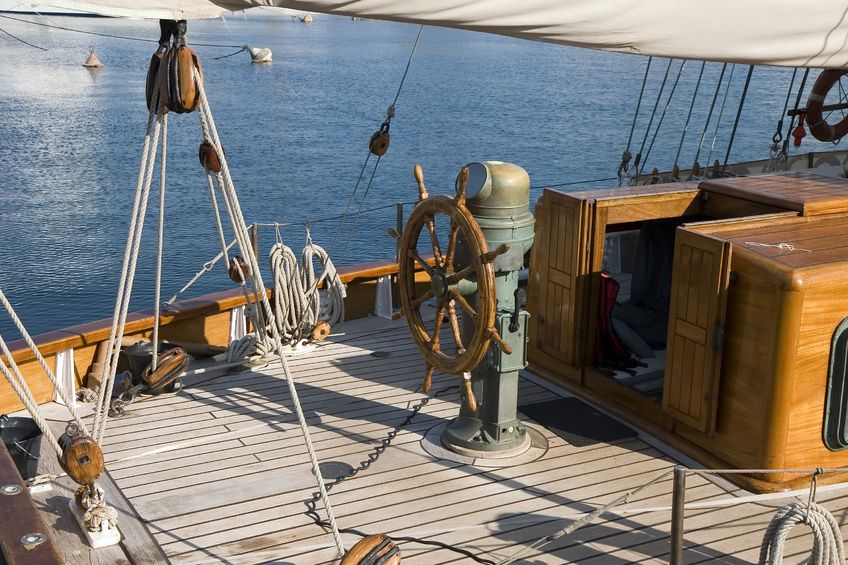 Qualified operation of a vessel equals seamanship. Tying knots and slicing lines – how good are you at this? Can you rig heavy weather lifelines? If you have a boat, do you know what equipment is needed to safely operate your boat? The skipper needs to have adequate skills for the boat that he chooses to purchase, own, and operate. Boats should be chosen accordingly. How much skill as a skipper do you possess? A skipper who accumulates a lot of experience and knowledge, is mature and has good judgment and is neither rash nor overly cautious will make a given vessel more seaworthy. In other words, the boat will be better able to safely carry on and not capsize or sink if commanded by a highly experienced captain.
Qualified operation of a vessel equals seamanship. Tying knots and slicing lines – how good are you at this? Can you rig heavy weather lifelines? If you have a boat, do you know what equipment is needed to safely operate your boat? The skipper needs to have adequate skills for the boat that he chooses to purchase, own, and operate. Boats should be chosen accordingly. How much skill as a skipper do you possess? A skipper who accumulates a lot of experience and knowledge, is mature and has good judgment and is neither rash nor overly cautious will make a given vessel more seaworthy. In other words, the boat will be better able to safely carry on and not capsize or sink if commanded by a highly experienced captain.
Safety is the name of the game when you’re out on a boat. Safety of your passengers should always take priority. A good bit of this is the safety aptitude of your vessel. Does your boat have high railings, good non-skid underfoot, plenty of grab rails, etc.? Learning how to handle YOUR boat is crucial. After purchasing your boat, head out to an area of water where you have clear manoeuvring room. Learn about your boat’s pivot point and focal point. Understanding what happens with a given amount of rudder in various conditions is the first step in becoming a good boat handler. Head to a marina where there is no one on the dock to practice docking. Make approaches and departures where there is plenty of room to practice docking between boats.
Learn to use spring lines to get away from the dock, eventually doing it with an on setting wind. Practice backing into a slip, picking one with no boats in the adjacent spaces. If you have twin engines, learn manoeuvrability of your rudders and just use the shift levers. Turning the wheel and using the throttles adds complexity and can get a novice into trouble quickly.
Navigation is more than just finding your way to a specific destination.
To navigate safely first of all requires situational awareness, which means you can see and hear what is around you, near and far, that could possibly pose a risk of collision or grounding. If you have radar, use it. Keep a proper lookout; the need for constant attention increases with traffic congestion, your boat’s speed, whether it’s day or night or foggy, and so on. Slow down or stop if you are uncertain of your position.
On cruises that will take longer than a half-day, set up a formal watch schedule so your boat is always operated by an alert, rested and experienced person who is familiar with the boat and its systems. Make sure you have trained enough of your family and friends to take the wheel and operate safely when you are down below and asleep. You should be on the bridge, or at the wheel, any time the boat enters congested waters or is otherwise put at more immediate risk by the proximity of hazards.
If you find yourself getting sleepy and there is no one qualified to run the boat, you might want to stop and drift or anchor while you take a nap, and instruct others to call you if another boat approaches. If you drop the hook, set an anchor watch to make sure you know if the anchor drags. Many GPS units have an anchoring mode that will sound an alert if the boat strays from a preset position. Make sure you have enough scope out for the conditions, have the right kind of anchor for the bottom, that it is large enough, and that it is properly set and holding. Drills and training
Before you head out, brief your passengers on the location of life jackets, how to use them, what to do if you fall overboard when the boat is running, how to use the VHF radio to call for help, and more. Everyone’s skills get stale after a while, so you should practice emergency procedures, especially if you head offshore any distance. The farther out you are, the less readily help is available, so you need to be on your game.
7 Critical Elements of the Seaman’s Art.” Soundings Online. Web. 31 Oct. 2012.
Follow Us: Facebook – Foursquare – Twitter – YouTube – LinkedIn

